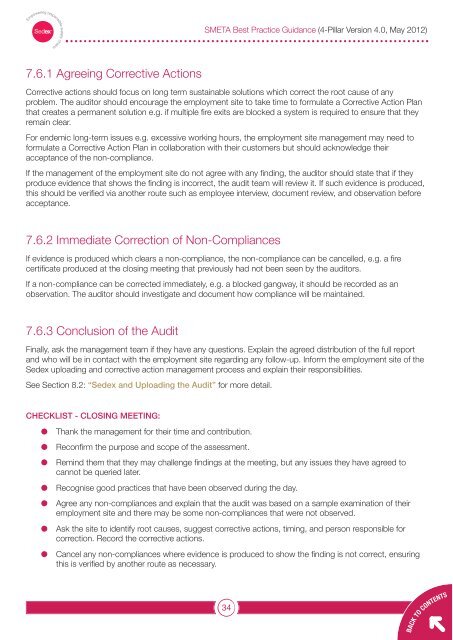Sedex Members Ethical Trade Audit (SMETA) Best Practice Guidance
Sedex Members Ethical Trade Audit (SMETA) Best Practice Guidance
Sedex Members Ethical Trade Audit (SMETA) Best Practice Guidance
You also want an ePaper? Increase the reach of your titles
YUMPU automatically turns print PDFs into web optimized ePapers that Google loves.
7.6.1 Agreeing Corrective Actions<br />
Corrective actions should focus on long term sustainable solutions which correct the root cause of any<br />
problem. The auditor should encourage the employment site to take time to formulate a Corrective Action Plan<br />
that creates a permanent solution e.g. if multiple fire exits are blocked a system is required to ensure that they<br />
remain clear.<br />
For endemic long-term issues e.g. excessive working hours, the employment site management may need to<br />
formulate a Corrective Action Plan in collaboration with their customers but should acknowledge their<br />
acceptance of the non-compliance.<br />
If the management of the employment site do not agree with any finding, the auditor should state that if they<br />
produce evidence that shows the finding is incorrect, the audit team will review it. If such evidence is produced,<br />
this should be verified via another route such as employee interview, document review, and observation before<br />
acceptance.<br />
7.6.2 Immediate Correction of Non-Compliances<br />
If evidence is produced which clears a non-compliance, the non-compliance can be cancelled, e.g. a fire<br />
certificate produced at the closing meeting that previously had not been seen by the auditors.<br />
If a non-compliance can be corrected immediately, e.g. a blocked gangway, it should be recorded as an<br />
observation. The auditor should investigate and document how compliance will be maintained.<br />
7.6.3 Conclusion of the <strong>Audit</strong><br />
Finally, ask the management team if they have any questions. Explain the agreed distribution of the full report<br />
and who will be in contact with the employment site regarding any follow-up. Inform the employment site of the<br />
<strong>Sedex</strong> uploading and corrective action management process and explain their responsibilities.<br />
See Section 8.2: “<strong>Sedex</strong> and Uploading the <strong>Audit</strong>” for more detail.<br />
CHECKLIST - CLOSING MEETING:<br />
l Thank the management for their time and contribution.<br />
l Reconfirm the purpose and scope of the assessment.<br />
l Remind them that they may challenge findings at the meeting, but any issues they have agreed to<br />
cannot be queried later.<br />
l Recognise good practices that have been observed during the day.<br />
<strong>SMETA</strong> <strong>Best</strong> <strong>Practice</strong> <strong>Guidance</strong> (4-Pillar Version 4.0, May 2012)<br />
l Agree any non-compliances and explain that the audit was based on a sample examination of their<br />
employment site and there may be some non-compliances that were not observed.<br />
l Ask the site to identify root causes, suggest corrective actions, timing, and person responsible for<br />
correction. Record the corrective actions.<br />
l Cancel any non-compliances where evidence is produced to show the finding is not correct, ensuring<br />
this is verified by another route as necessary.<br />
34<br />
BACK TO CONTENTS


